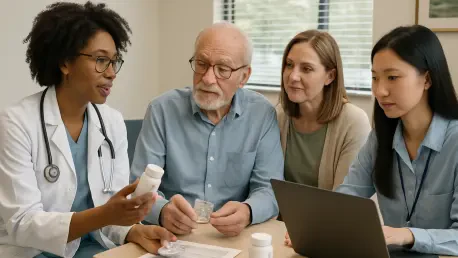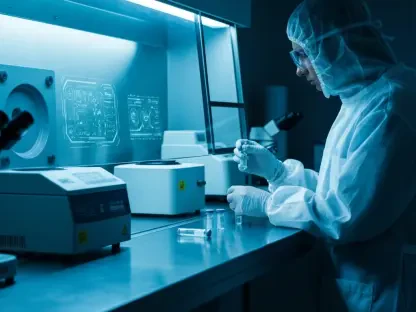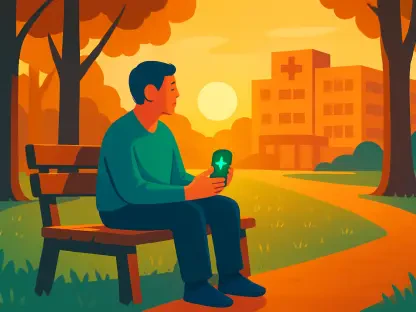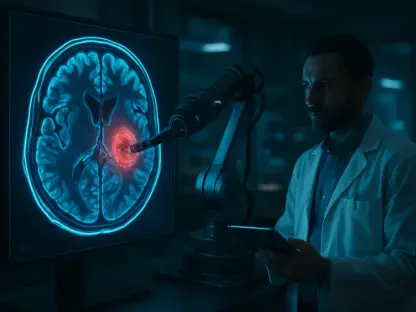In the intricate world of drug development, where every trial holds the potential to transform lives, a quiet revolution is unfolding in the unassuming spaces of suburban medical corridors, reshaping how research reaches communities. Outpatient clinics, traditionally viewed as mere venues for routine healthcare like check-ups and minor treatments, are now stepping into a pivotal role as essential hubs for clinical research. This transformation is driven by a convergence of economic vigor, technological progress, and a critical need to make drug trials more accessible and representative of diverse populations. As the pharmaceutical industry grapples with significant challenges—such as the fact that 75% of clinical studies miss enrollment targets or timelines—these medical outpatient buildings (MOBs) are emerging as a solution to bridge geographic and demographic gaps. Their proximity to communities and evolving infrastructure are redefining how research is conducted, making them indispensable in the quest to bring new therapies to market.
The stakes couldn’t be higher, with many potential participants living over two hours from major academic medical centers, creating substantial barriers to trial participation. Outpatient clinics are uniquely positioned to address this issue by bringing research directly into local settings. Meanwhile, investor interest is surging, with MOBs standing out as a bright spot in a struggling real estate market. With vacancy rates under 10% and significant capital inflows, these facilities are not just healthcare spaces but also strategic assets for the future of clinical trials. This shift, supported by the rise of decentralized trial models and a push for diversity, signals a profound change in the landscape of drug development, one where outpatient clinics are at the forefront.
Economic Trends Driving MOB Investment
A Bright Spot in Real Estate
The real estate market is witnessing a remarkable divergence, where traditional office spaces in central business districts struggle with high vacancy rates—projected to peak at 19% in the coming years—while medical outpatient buildings flourish with rates below 10%. This contrast highlights MOBs as a rare beacon of stability, commanding record-high asking rents and drawing substantial investor interest. In just one recent quarter, a staggering $2.7 billion was funneled into these properties, reflecting a 27% increase from the prior period. Such financial enthusiasm underscores the perception of MOBs as a resilient asset class, especially when compared to the broader office market’s challenges. Their ability to maintain positive net absorption further cements their status as a safe haven for capital in uncertain times, positioning them as more than just healthcare facilities but as critical infrastructure for other industries as well.
Beyond the numbers, the appeal of MOBs lies in their dual role as both stable healthcare providers and emerging research platforms. Sale prices for these buildings are significantly higher than for traditional offices, with a premium that reflects investor confidence in their long-term value. This economic strength is not merely a trend but a structural shift, as the demand for accessible, community-based medical spaces grows alongside the needs of the pharmaceutical sector. The low cap rates associated with MOBs compared to standard office properties further illustrate a market belief in their durability. As capital continues to flow into this sector, it becomes clear that outpatient clinics are not just surviving but thriving amid broader economic headwinds, setting the stage for their expanded role in clinical research.
Investor Confidence in Research Infrastructure
Investor enthusiasm for MOBs goes beyond traditional healthcare applications, focusing on their potential as research hubs integral to drug development. The rising sale prices and consistent absorption rates—evidenced by hundreds of thousands of square feet of positive uptake in recent quarters—demonstrate a deep-seated belief in the sustained demand for trial-ready facilities. Private equity firms and real estate investment trusts are not merely betting on brick-and-mortar assets but on the strategic importance of these spaces in addressing modern research challenges. Their investments are transforming outpatient clinics into environments capable of supporting complex clinical studies, aligning real estate trends with the evolving priorities of the biopharmaceutical industry.
This confidence is also reflected in the geographic focus of investments, targeting regions with high growth potential for both healthcare and research activities. Markets in the Southeast, Midwest, and Sun Belt are seeing significant capital inflows, aligning with areas prioritized by pharmaceutical companies for community engagement. The involvement of major stakeholders in upgrading MOB infrastructure to meet research demands further validates this trend. By equipping these facilities with advanced systems for data handling and secure storage, investors are ensuring that outpatient clinics can handle the rigors of clinical trials. This forward-thinking approach highlights a broader vision where MOBs are pivotal not just for care delivery but as essential cogs in the machinery of drug innovation.
Addressing Challenges in Clinical Trials
Overcoming Geographic Barriers
One of the most persistent obstacles in clinical trials is the geographic isolation of potential participants, with studies indicating that 70% live more than two hours from major research centers. This distance creates significant logistical challenges, including travel time and associated costs, often deterring individuals from enrolling in studies. Outpatient clinics, strategically located in suburban and community settings, offer a practical solution by bringing trial sites closer to where people live. This proximity not only reduces the burden on participants but also helps research organizations meet enrollment timelines more effectively. By decentralizing trial locations, MOBs are dismantling barriers that have long hindered the efficiency of drug development, ensuring that studies can reach a broader pool of candidates without the constraints of centralized academic hubs.
The impact of this shift is profound, as it addresses a core reason why many trials fail to meet their targets. Outpatient facilities provide a more convenient access point, often integrated into familiar local healthcare environments, which can ease the apprehension associated with participating in research. This accessibility extends beyond mere location; it encompasses the ability to conduct follow-ups and monitoring in settings that are part of participants’ everyday lives. The result is a more seamless integration of research into routine healthcare, reducing dropout rates and enhancing the overall quality of data collected. As the industry continues to prioritize patient-centric models, the role of MOBs in overcoming geographic hurdles becomes increasingly central, paving the way for more inclusive and efficient clinical studies.
Boosting Diversity and Community Engagement
Diversity in clinical trials remains a critical issue, with minority participation often languishing below 10% in many studies, largely due to historical mistrust and logistical barriers. Outpatient clinics, embedded within diverse community settings, are uniquely positioned to address this gap by offering a less intimidating environment compared to large academic medical centers. Their location reduces travel burdens, making participation more feasible for underrepresented groups who might otherwise be excluded from research opportunities. By fostering a sense of familiarity and trust, these facilities help bridge cultural and social divides, encouraging broader enrollment and ensuring that trial outcomes better reflect real-world demographics.
This focus on community engagement extends to building relationships that counteract past ethical missteps in medical research, which have left lasting skepticism among certain populations. MOBs serve as accessible entry points where outreach and education can occur alongside trial activities, helping to rebuild confidence in the research process. Their presence in local areas allows for tailored recruitment strategies that resonate with specific demographic needs, enhancing the representativeness of study cohorts. Moreover, the integration of community-based clinics into trial networks supports regulatory goals for diversity, aligning with industry mandates to produce more equitable health solutions. As such, outpatient facilities are not just logistical assets but also vital tools for social progress within clinical research.
The Evolution of Outpatient Clinics
From Care Centers to Research Hubs
Outpatient clinics are undergoing a dramatic operational transformation, evolving from traditional care centers into sophisticated research hubs capable of supporting advanced clinical studies. Private site networks and research organizations are increasingly leasing spaces in modern MOBs to conduct phase II and III trials, outfitting them with cutting-edge infrastructure. This includes robust power systems, specialized HVAC for controlled environments, secure drug storage, and sample processing rooms. Such upgrades signify a departure from their conventional role, positioning these facilities as integral components of the drug development pipeline. The shift is further fueled by private investments that recognize the strategic value of MOBs in meeting the growing demands of pharmaceutical research.
This evolution is not merely about physical upgrades but also about redefining the purpose of outpatient spaces within the healthcare ecosystem. By hosting complex trials, MOBs are blurring the boundaries between routine medical care and experimental research, creating hybrid environments that serve dual purposes. The involvement of major players in equipping these clinics with high-speed data connectivity reflects an understanding of the data-intensive nature of modern trials. As a result, what were once simple doctor’s offices are now becoming powerhouses of innovation, capable of handling the intricacies of clinical studies far from traditional hospital settings. This transformation underscores the adaptability of MOBs in responding to the dynamic needs of the biopharmaceutical sector.
Supporting Decentralized Trial Models
The rise of decentralized clinical trials (DCTs), valued at $9.4 billion currently and projected to double by 2030, marks a significant shift toward patient-centric research, with outpatient clinics at the heart of this model. DCTs aim to bring studies directly to participants, minimizing the need for travel to centralized sites. MOBs serve as the physical touchpoints for these decentralized approaches, providing local venues where patients can engage in trial activities without the burden of long commutes. Their role as accessible trial sites aligns seamlessly with the industry’s push for efficiency and broader reach, ensuring that research protocols can be executed in settings that prioritize participant convenience.
This alignment with DCTs also highlights the scalability of outpatient facilities in adapting to innovative trial designs. Equipped to handle remote monitoring and data collection, MOBs enable seamless integration of digital tools that are hallmarks of decentralized models. Their community-based nature further supports retention by offering continuity of care alongside research activities, fostering a sense of stability for participants. As the DCT market continues to grow at an impressive rate, the reliance on outpatient clinics as operational bases will only intensify. This positions MOBs not just as supplementary assets but as cornerstone elements of a research framework that values accessibility and patient engagement above all, reshaping how clinical trials are conceptualized and conducted.
Strategic Synergies in Drug Development
Aligning Real Estate with Pharma Priorities
A striking synergy is emerging between the geographic focus of MOB investments and the strategic priorities of the pharmaceutical industry, particularly in high-growth regions like the Southeast and Sun Belt. Major companies have committed billions over the next five to ten years to bolster U.S.-based research and biomanufacturing, creating a demand for localized trial infrastructure. Outpatient clinics in these areas are becoming the backbone of community-based research, ensuring that trial sites are situated where both population density and industry focus intersect. This alignment enhances the efficiency of drug development by placing research capabilities in proximity to target demographics, supporting faster enrollment and more relevant data collection.
This strategic overlap is not coincidental but a deliberate response to the evolving needs of clinical research. Investment hotspots for MOBs mirror the regions prioritized for pharmaceutical expansion, reflecting a shared vision among stakeholders to optimize resources. The result is a network of outpatient facilities that are not only financially viable but also operationally critical to meeting industry goals. By situating trial sites in areas with growing healthcare demands, MOBs help address regional disparities in research access, ensuring that drug development efforts are both equitable and effective. This geographic congruence underscores the pivotal role of outpatient clinics in shaping a future where research infrastructure is as dynamic as the industry it serves.
Integrating Technology and Innovation
Significant investments from private equity and real estate investment trusts are driving the integration of cutting-edge technology into outpatient clinics, transforming them into hybrid spaces where clinical care and research coexist. Upgrades such as advanced data systems and digital tools are being embedded into MOBs to support the intensive data collection required by modern trials. This focus on technological enhancement ensures that these facilities can handle the complexities of clinical studies, from secure storage of sensitive materials to real-time data transmission. The result is a seamless blend of healthcare delivery and research activity, positioning outpatient clinics as innovative nodes within the broader drug development ecosystem.
This technological push also reflects a broader industry trend toward leveraging digital solutions to streamline trial processes. MOBs equipped with state-of-the-art infrastructure can support remote monitoring and telehealth components, aligning with the demands of decentralized models. Such advancements not only improve operational efficiency but also enhance participant experience by minimizing disruptions to their daily lives. The commitment to innovation within these spaces, backed by substantial financial support, signals a long-term vision for outpatient clinics as integral to the future of research. As technology continues to evolve, MOBs stand ready to adapt, ensuring that they remain at the forefront of delivering both care and cutting-edge clinical insights.
Looking Ahead: Building a Research-Friendly Future
Reflecting on the journey of outpatient clinics, it’s evident that their evolution into vital components of drug trials marked a turning point in how clinical research is approached, transforming accessibility for diverse communities. Their ability to address geographic and demographic challenges reshaped trial accessibility, while robust investor support fueled their transformation into technologically advanced hubs. The strides made in integrating community-based facilities into decentralized models demonstrated a commitment to inclusivity and efficiency that redefined industry standards. As this shift gained momentum, outpatient clinics became more than just healthcare spaces; they emerged as cornerstones of a research landscape that prioritized real-world impact. Moving forward, stakeholders must continue to invest in upgrading MOB infrastructure, ensuring these facilities can support emerging trial methodologies. Collaboration between real estate, technology, and pharmaceutical sectors will be key to sustaining this progress, while targeted efforts to engage diverse communities through local clinics should remain a priority. By focusing on these actionable steps, the legacy of outpatient clinics as indispensable research assets can be secured for generations to come.









